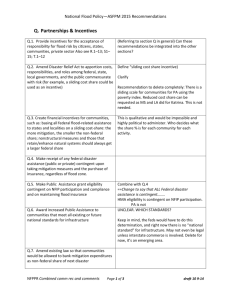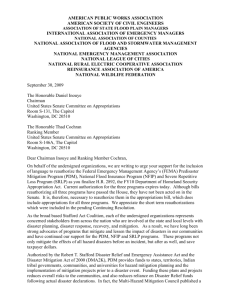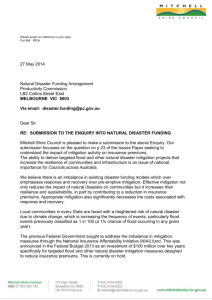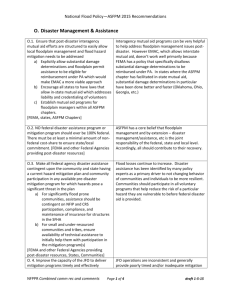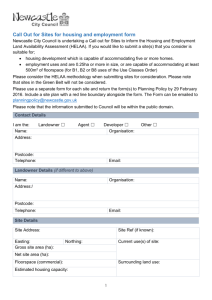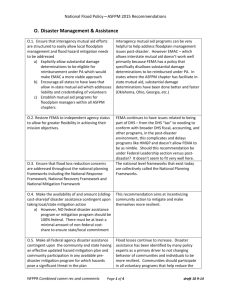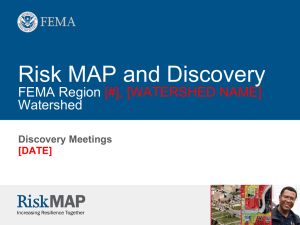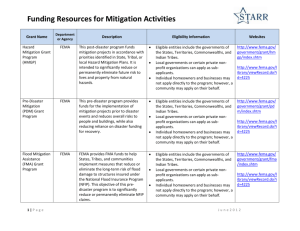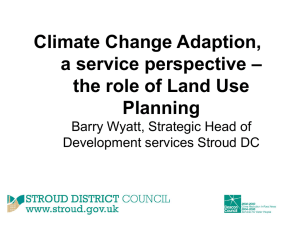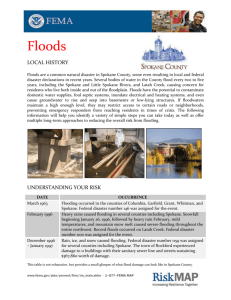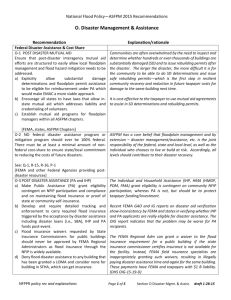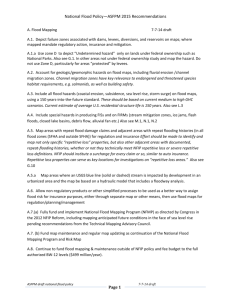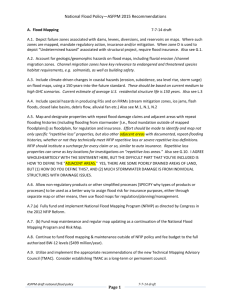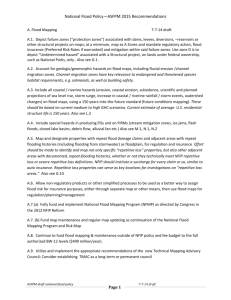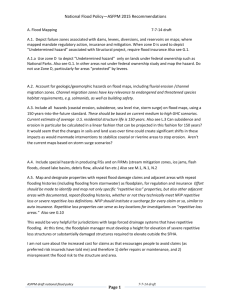Disaster Management & Assistance
advertisement
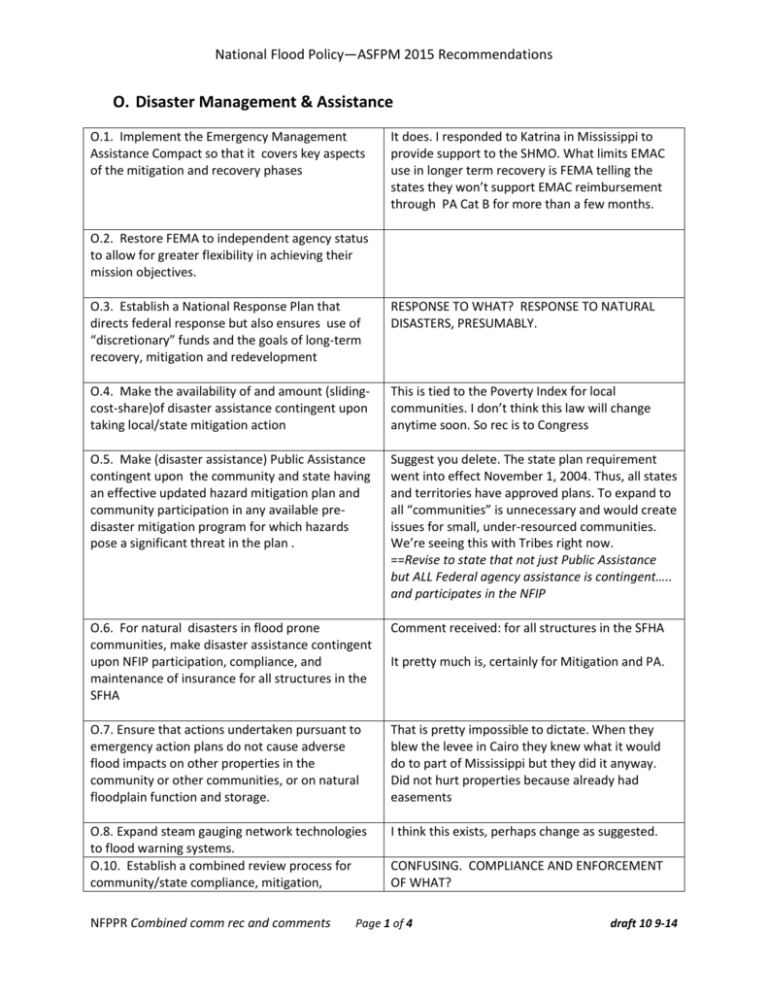
National Flood Policy—ASFPM 2015 Recommendations O. Disaster Management & Assistance O.1. Implement the Emergency Management Assistance Compact so that it covers key aspects of the mitigation and recovery phases It does. I responded to Katrina in Mississippi to provide support to the SHMO. What limits EMAC use in longer term recovery is FEMA telling the states they won’t support EMAC reimbursement through PA Cat B for more than a few months. O.2. Restore FEMA to independent agency status to allow for greater flexibility in achieving their mission objectives. O.3. Establish a National Response Plan that directs federal response but also ensures use of “discretionary” funds and the goals of long-term recovery, mitigation and redevelopment RESPONSE TO WHAT? RESPONSE TO NATURAL DISASTERS, PRESUMABLY. O.4. Make the availability of and amount (slidingcost-share)of disaster assistance contingent upon taking local/state mitigation action This is tied to the Poverty Index for local communities. I don’t think this law will change anytime soon. So rec is to Congress O.5. Make (disaster assistance) Public Assistance contingent upon the community and state having an effective updated hazard mitigation plan and community participation in any available predisaster mitigation program for which hazards pose a significant threat in the plan . Suggest you delete. The state plan requirement went into effect November 1, 2004. Thus, all states and territories have approved plans. To expand to all “communities” is unnecessary and would create issues for small, under-resourced communities. We’re seeing this with Tribes right now. ==Revise to state that not just Public Assistance but ALL Federal agency assistance is contingent….. and participates in the NFIP O.6. For natural disasters in flood prone communities, make disaster assistance contingent upon NFIP participation, compliance, and maintenance of insurance for all structures in the SFHA Comment received: for all structures in the SFHA O.7. Ensure that actions undertaken pursuant to emergency action plans do not cause adverse flood impacts on other properties in the community or other communities, or on natural floodplain function and storage. That is pretty impossible to dictate. When they blew the levee in Cairo they knew what it would do to part of Mississippi but they did it anyway. Did not hurt properties because already had easements O.8. Expand steam gauging network technologies to flood warning systems. O.10. Establish a combined review process for community/state compliance, mitigation, I think this exists, perhaps change as suggested. NFPPR Combined comm rec and comments It pretty much is, certainly for Mitigation and PA. CONFUSING. COMPLIANCE AND ENFORCEMENT OF WHAT? Page 1 of 4 draft 10 9-14 National Flood Policy—ASFPM 2015 Recommendations enforcement after a flood Clarify. As written doesn’t make any sense. O.11. Establish a comprehensive set of emergency rules for funding, cost-sharing, and priorities so federal programs after a disaster are consistent in flood prone areas The rules are comprehensive and consistent, except with policy directives issued by the FCO or high level feds to deal with specific situations. Sometimes these policies are tested this way and then institutionalized for all. I’d delete. O.12. Establish a uniform set of application forms for all federal post-disaster assistance for mitigation O.13. Work with all federal agencies to ensure post-disaster policies and programs are consistent with NFIP and national resilience/sustainability goals SEVERAL OF THESE RECOMMENDATIONS OVERLAP AND WOULD BE MORE EFFECTIVE IF SMOOTHLY COMBINED 11,12,13? O.14. Review PA and IAHP and all federal agency post disaster programs for consistency with all relevant federal Executive Orders (especially floodplains, wetlands, resilience and climate change) ==Make sure that ALL federal programs are consistent in terms of supporting and reducing flood risk. Right now, PA and IA are often adverse to the goals of flood risk reduction of the NFIP IAHP really has nothing to do with these issues. It’s repair, temp housing grants. PA goes through a NEPA review covering NFIP and wetlands, other EHP. So what is left is resilience and climate change. Resilience can be addressed somewhat through PA 406 Mitigation, addressed in H. Climate change is sort of related where flood intensity and levels increase. So perhaps modify or delete. O.15. Ensure that PA staff and contractors have expertise to make decisions about post-disaster reconstruction of public infrastructure and facilities that incorporate mitigation Move to Mitigation? Or x-ref Perhaps this one should require “mit was considered checkoff on all PWs O.16. Revise Stafford Act provisions to allow reimbursement under EMAC? of overwhelmed communities for post-disaster damage assessments, substantial damage determination, ordinance administration, permitting up to 24 months after disaster O. 17. Collect and share damage assessment under IA with State and local officials Who does this? Privacy Act protects Collected inspection information. Who will be in charge of seeing that this gets done? Totally unnecessary. The inspection is done to assess eligibility for repair grants and temp NFPPR Combined comm rec and comments Page 2 of 4 draft 10 9-14 National Flood Policy—ASFPM 2015 Recommendations housing. What is done requiring a building permit is between the owner and local government, FEMA permits trailers with the community. So the inspection data should not be shared, states and locals don’t need it. They should be enforcing their own laws and doing their own substantial damage, public health and nuisance, etc. inspections and enforcing their laws wow? O.18. Develop and utilize methods to track all federal expenditures and lost revenue due to each disaster declaration in order to determine the full cost to society and taxpayers of disasters. Publish preliminary results within one year of the declaration and final results within 5. Within 5 ?? What would we do with this information? Economists and universities have done lots of studies on multipliers of lost revenues, business and societal impacts of disasters. Federal expenditures can be obtained. Q 19. Establish a federal oversight group similar to the National Transportation Safety Board, to collect data and analyze the damages, cause and economic, social and environmental impacts of all disasters Ok, then what? NTSB makes recommendations pertinent to the transportation industry – what would this group do? Add what they would do O.20. Require all federal recovery programs be reviewed and adjusted to consider mitigation and resiliency alternatives and evaluate long term solutions (require that water resource projects and PL 84-99 for example consider non-structural measures ) FOR WATER RESOURCE PROJECTS IN GENERAL, THE NON-STRUCTURAL PREFERENCE IS ALREADY WRITTEN INTO THE NEW PRINCIPLES AND REQUIREMENTS-but not implemented O.21. FEMA, in consultation with other appropriate federal agencies, develop and maintain a national comprehensive strategic framework for mitigation and mitigation related metrics that are used to measure the success of a post-event disaster recovery. Require that mitigation metric be developed by MitFLG and used as an indicator of a successful disaster management and recovery Roy would tell you that its in PPD-8. I think what is missing are the performance metrics. I’ve been trying to figure out what those should be since Hurricane Fran – 1996. O. 22. Improve the efficiency and delivery of HMTAP such as allowing FCOs to approve requests in the field versus FEMA Regions or FEMA HQ. We could add “within approved guidelines” Include integration of natural floodplain ecosystem benefits for long terms resilience solutions. O. 24. Assist in Building State Capability in ?? Including Mechanisms to Assist with Catastrophic NFPPR Combined comm rec and comments Page 3 of 4 draft 10 9-14 National Flood Policy—ASFPM 2015 Recommendations and Multiple Events. O. 25. Improve the Federal Government’s Ability to Supplement State Program’s Capability with Robust and Timely Technical Assistance in a PostDisaster Environment. This really doesn’t say anything. The regional feds show up FAST to state EOPs and get JFOs up in a couple of days post-declaration. I don’t think this is necessary. O. 26. Require detailed tracking and enforcement of required flood insurance on Group Flood Insurance Policies and flood insurance on SBA Disaster Loans post-Flooding. Flood insurance should also be required on SBA Disaster Loans that are in NSFHAs. x-ref to similar in G insurance O.27. Consider the additional Local Hazard Mitigation Planning effort of a community-led post-disaster relocation and recovery planning prior to flooding or other hazard events. Consider when and how? O.28. Support/develop/promote apps or other crowd-sourcing approaches for immediate disaster notification or for post-disaster recovery information dissemination. NFPPR Combined comm rec and comments Page 4 of 4 draft 10 9-14
